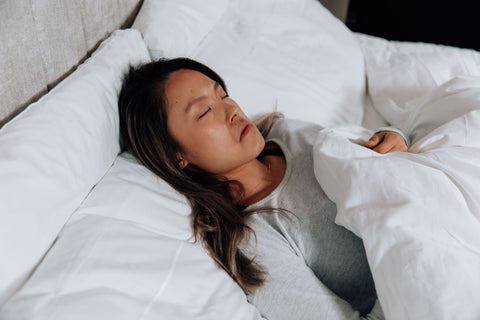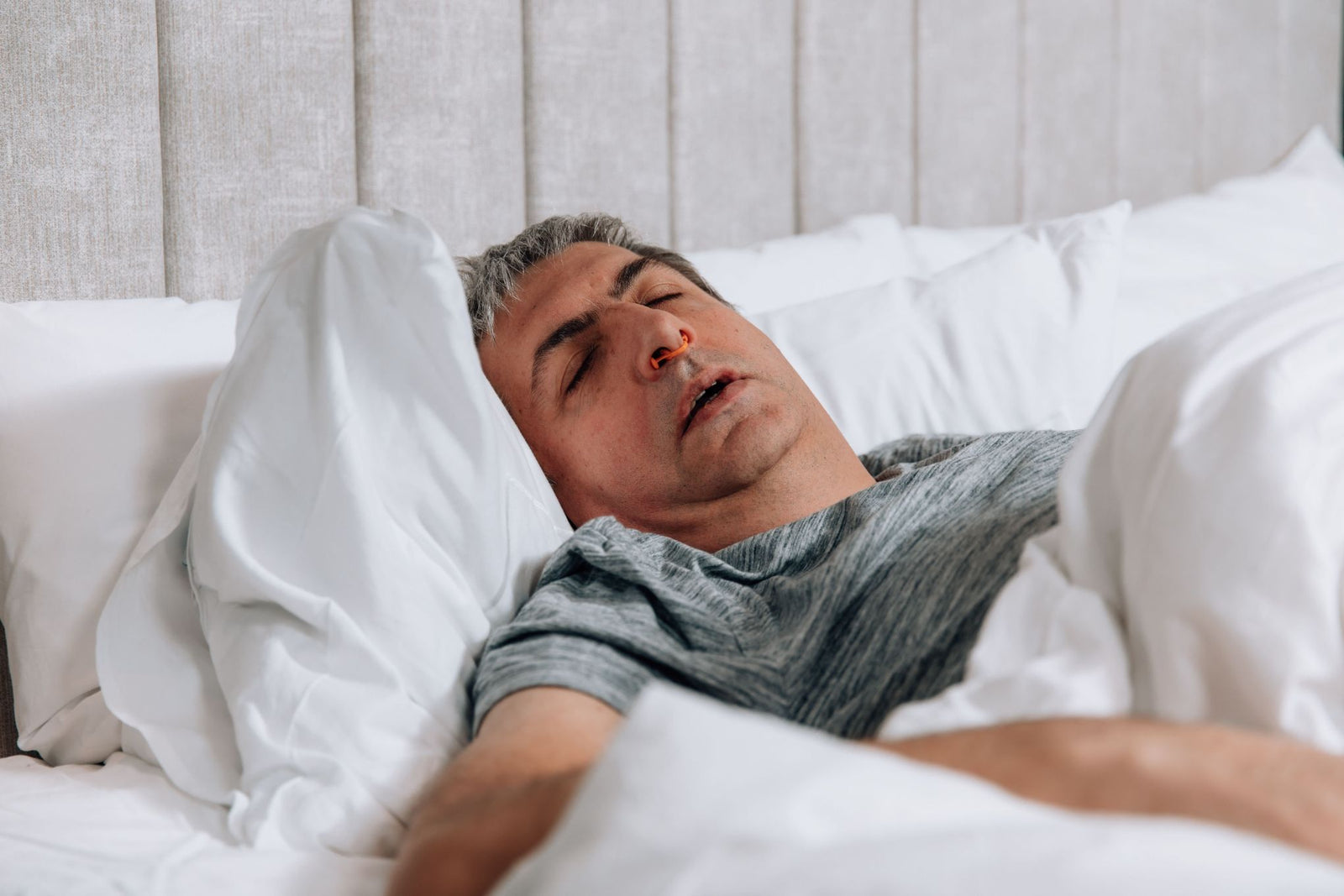Fragmented sleep is a widespread issue that affects the majority of adults.
Challenges with sleep are actually more common than not. In truth, nearly half of all Americans report feeling sleepy during the day at least three times per week.
Moreover, some Americans report feeling sleepy during the dayevery day of the week. And, believe it or not, the way you breathe during sleep directly affects your sleep quality.

If you can’t control mouth breathing when sleeping, a well-rested night is out of reach.
Mouth Breathing Fragments Sleep (And Wellbeing)
Breathing through the mouth rather than the nose not only fragments your sleep – over time it has detrimental consequences to your health.
Mouth breathing activates the fight or flight stress response within the body, placing the body and mind into overdrive.
This is largely because mouth breathing constricts blood vessels in the lungs, leading to poor oxygenation.
As your mouth falls open, the jaw drops. Tissues in and around the airway then cause a blockage of the airway tissues. These tissues vibrate together, producing the dreaded sound of snoring. The sound of snoring produced by mouth breathing disrupts both you and your partner’s sleep, causing daytime fatigue.

Beyond that, mouth breathing may lead to more trips to the dentist.
The physical action of an open mouth leads to dry mouth — a huge threat to your oral health. Cavities, gum disease, decay, and chronic bad breath are all tied to dry mouth caused by mouth breathing.
Saliva coats the teeth, protecting them from damage caused by bacteria and germs. Mouth breathing evaporates the protective layer of saliva, leaving the teeth defenseless against acidic plaque as you rest.
@somnifix Your #dentist knows if you’re a 👄 breather or a 👃 breather 👀 #oralhealth #learnontiktok #didyouknow #breathingexercises via @Dr Vikas Prinja ♬ So Hot You're Hurting My Feelings - Caroline Polachek
Nasal breathing, on the other hand, allows the saliva to lubricate and protect the teeth. It also activates our parasympathetic nervous system, which helps us “rest and digest.”
This physiological response helps us to achieve and maintain deep, restful sleep by relaxing the body and mind, bringing down blood pressure, and slowing our breathing. As a result, quality sleep is more achievable.
Now that we know how mouth breathing fragments sleep (and why nasal breathing is the superior method of breathing), you may be wondering, “how do I make the switch?”
The fastest way to get used to nasal breathing at night is to practice nasal breathing during waking hours.
1. Train Your Way During the Day
Strangely enough, there is a right and wrong way to rest your tongue within your mouth.
If your tongue rests on the bottom of your mouth, you may be more prone to mouth breathing. However, if your tongue rests in the proper position, nasal breathing is more likely.
Put simply, if you can’t control mouth breathing when sleeping, the quickest way to correct the problem is to develop a proper tongue posture.

So what is the right way to hold your tongue within your mouth? The tongue should rest against the roof of the mouth at the back, middle, and tip. It should sit just behind slightly parted teeth with the lips sealed.
In this posture, the only way to exchange oxygen is through the nostrils. This posture is commonly referred to as “mewing.”
You may not be able to achieve proper tongue posture at first. Like all great things in life, practice makes perfect.
Checking in with yourself often throughout the day to notice your tongue posture and breathing is the first step toward correcting your breathing patterns.
Try an app like “MEW” to improve your tongue posture and stay consistent and accountable on your nasal breathing journey.
Another method to receive regular reminders to nasal breathe? Set multiple alarms on your phone throughout the day reminding you to close your mouth while you breathe.

Over time – and with lots of practice – your breathing method will default to nasal breathing over mouth breathing. Once you’ve mastered nasal breathing during waking hours, you’ll be more likely to nasal breathe as you sleep.
While switching over, you may notice that congestion seems to get in the way of your progress. That’s why clearing congestion is key to controlling mouth breathing when sleeping.
2. Clear Congestion
Nasal breathing not only takes the body out of fight or flight, reduces snoring, and improves our oral health; it also filters and humidifies the air we breathe.
The nose is full of small hairs called cilia that filter out debris, dust, dirt, and harmful pathogens. This translates to a huge immunity boost!
Additionally, the nostrils add moisture and control the temperature of our breath. That means cold air is warmed while hot air is cooled before hitting the lungs. Oxygen absorption and exchange then requires less work, since the breath is temperature regulated.
One main challenge when making the switch? Congestion is a large contributor to why you can’t control mouth breathing when sleeping. If you’ve been a chronic mouth breather for any length of time, your congestion will make your journey much more difficult.
Mouth breathing causes congestion, which leads to more mouth breathing, which causes congestion, which worsens mouth breathing.
Before you attempt to clear the congestion, meet with your physician to rule out allergies or a deviated septum as the cause.
Then, try a nasal clearing exercise such as Buteyko breathing to drain the nasal cavity and clear the nostrils of congestion.
You may also benefit from sleeping with a nasal dilator. Nasal dilators are widely effective at improving nasal airflow. In fact, research shows that they improve oxygen exchange within the nasal cavity by over 18%.
There are two commonly used types: internal and external dilators.
External dilators are the more popular version, also called nasal strips. You can usually find these at any drug store and simply adhere one to the outside of your nose before bed.

Internal dilators are placed within the nose, keeping the nostrils open from within.
There’s only one downside to using nasal dilators: your mouth can still fall open during sleep. That’s where mouth taping takes the cake.
3. Tape Your Mouth Closed
It sounds outlandish, but taping your mouth closed ensures that your mouth can’t physically fall open as you dream. Fatigue, fragmented sleep, dry mouth, and bad breath are a thing of the past with the use of mouth tape.
When you tape your mouth at night, the top and lower lips remain sealed, putting an end to open-mouth breathing and snoring.

In sleep apnea sufferers, mouth tape has been proven to reduce lapses in breathing throughout the night and improve oxygenation.
Due to this, mouth tape can be used in combination with CPAP therapy without the need for uncomfortable chin straps.
Better yet, you can use both mouth tape and nasal dilators at the same time for ultimate mouth breathing prevention.
Before you reach for any tape, be sure to choose a skin safe option.
Use SomniFix to Control Mouth Breathing When Sleeping
If you can’t control mouth breathing when sleeping, your best bet is to keep your mouth closed with tape as you sleep. There’s just one problem.
Most tape contains harmful chemicals that irritate the skin, causing rashes and irritation. SomniFix Mouth Strips offer just the opposite: skin-safe adhesion that’s hypoallergenic and free from latex and gluten.

Our Strips offer a unique breathing vent in cases of emergency where mouth breathing is necessary, such as cases of severe overnight congestion.
Add SomniFix to your nightly routine and reap the benefits (and improved sleep) that come with nasal breathing!




